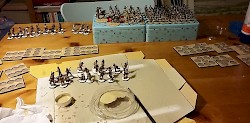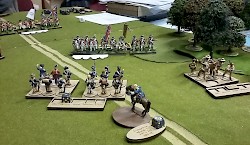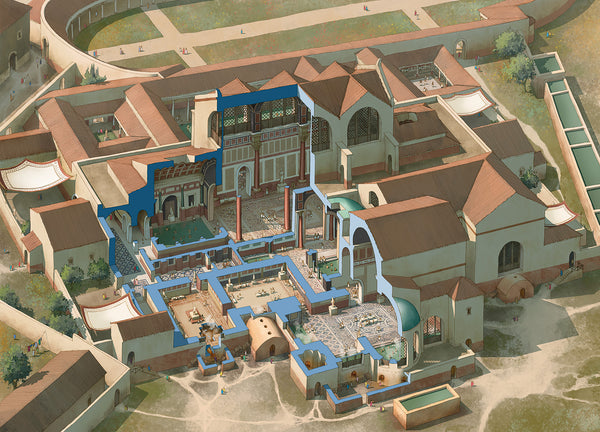The Dutch AWI Project - final week - 2
 I write this at the end of an evening where I have based my prospective army for the big battle on Sunday. It’s the worst job I can think of in preparing a wargaming army. I resent it like nothing else (Ed: the WSS editor is not fond of it either). And yet, this means that I’m about to finish the job. Perhaps tomorrow night it will all be done. Or perhaps Friday. Or Saturday. But I will make this deadline.
I write this at the end of an evening where I have based my prospective army for the big battle on Sunday. It’s the worst job I can think of in preparing a wargaming army. I resent it like nothing else (Ed: the WSS editor is not fond of it either). And yet, this means that I’m about to finish the job. Perhaps tomorrow night it will all be done. Or perhaps Friday. Or Saturday. But I will make this deadline.
And not just make it. Sunday morning sun rising, I will have the four regiments of Smallwood’s brigade present at the battle of Camden ready. And more: woodland Indians, Stockbridge Indians and surplus militia. That is far beyond what I had thought to achieve when starting on this journey a year ago. I even slipped in painting three Dark Age houses just last week.
 That doesn’t mean there isn’t a pile of pewter and plastic lying in wait for me still. Some last Indians and militia, several units of British and loyalist troops and the 2nd South Carolina regiment. But that is all beyond the task I set myself, so no worries there. I’ll probably just be beaming from pride on Sunday no matter the outcome of the game.
That doesn’t mean there isn’t a pile of pewter and plastic lying in wait for me still. Some last Indians and militia, several units of British and loyalist troops and the 2nd South Carolina regiment. But that is all beyond the task I set myself, so no worries there. I’ll probably just be beaming from pride on Sunday no matter the outcome of the game.
In further developments in preparation for the big day, I did manage another test game of Land of the Free last week. This was very useful. Needless to say I got my behind handed to me by Patrick. I will need to read through the rules again and again though, because I keep finding rules I’ve overlooked or misinterpreted.
 Apart from the painting challenge and the rules, and in direct contradiction to my intentions at the start, this has turned into a reading project as well. Over a dozen Ospreys somehow came into my possession, and a further dozen paper and digital books on the AWI. And somehow I managed to read most of them.
Apart from the painting challenge and the rules, and in direct contradiction to my intentions at the start, this has turned into a reading project as well. Over a dozen Ospreys somehow came into my possession, and a further dozen paper and digital books on the AWI. And somehow I managed to read most of them.
I was first infatuated with the militia side of the war; then the Indian conflict grabbed my attention. Four of the books I bought on my summer holiday to the UK dug deeper into the subject. I discovered the Black Dragoons of South Carolina, and how choosing to become a loyalist sometimes depended more on the side that the people you hated chose, than on your ideology.
 But the crown on my reading spree has been Barbarians & Brothers by Wayne Lee, a brilliant book weaving together the civil and colonial wars in England, Ireland and North America from the 16th to the 19th century. Lee explains how conflicts between civilians and between cultures turned much more violent than between regulars. This clash of regular soldiers, warriors and citizens in these centuries, and more specifically in the AWI, has proved a fascinating discovery that I had not expected a year ago.
But the crown on my reading spree has been Barbarians & Brothers by Wayne Lee, a brilliant book weaving together the civil and colonial wars in England, Ireland and North America from the 16th to the 19th century. Lee explains how conflicts between civilians and between cultures turned much more violent than between regulars. This clash of regular soldiers, warriors and citizens in these centuries, and more specifically in the AWI, has proved a fascinating discovery that I had not expected a year ago.
That legacy will endure after Sunday.

